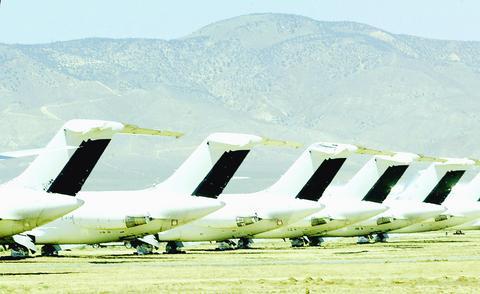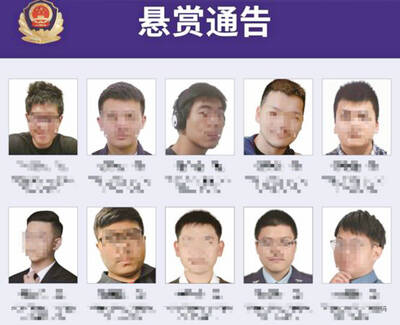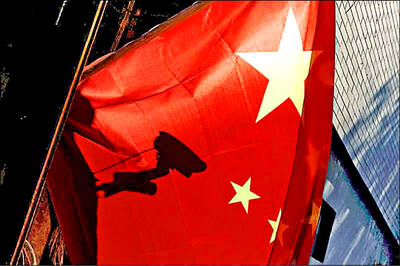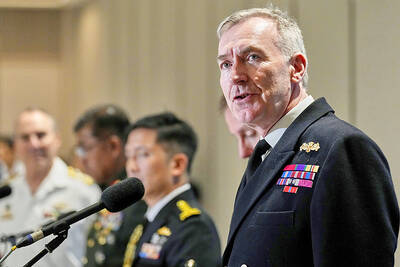No better barometer of the fortunes of the airline industry exists than 500 hectares of parched brown earth here, baking at 39?C.
Jetliners, row upon row of them, sit idle in three lots, their engines sealed with silver or black plastic Mylar, their tails rising from the flat desert like shark fins protruding from an ocean's glassy surface.
Rattlesnakes slither in the shadows of nose cones and tortoises hobble their way past landing gear. A yellow school bus carrying a dozen mechanics barrels between planes, kicking up dust.

PHOTO: NY TIMES
About 250 jets have been consigned to this purgatory, a storage and maintenance yard operated by Avtel Services. That number is four times as large as before the terror attacks of Sept. 11, 2001. When the airline business is lousy, the money can be good, and the general manager, Justin Loucks, says it will only get better.
"I don't think we've seen the end of the bankruptcies in the US," Loucks said as he stared out the window of his second-floor office at the field of planes. "Several companies are on the brink."
Ebb and flow
Avtel has 50 customers from around the world, and many have parked their multimillion dollar assets on Loucks' scorching front yard. There are silver Fokker 100s from ailing American Airlines, cherry red Boeing 737-200s from US Airways' failed Metrojet venture, hulking blue 747s from KLM, the Dutch airline. About 70 percent of the planes are from lessors and the leasing arms of companies like Bank of America and General Electric, the rest from the airlines themselves.
The ebb and flow of planes serves as a gauge of both industrywide health and the strength of individual airlines. There are other indicators of the state of airline economics as well. For instance, Avtel is getting a flood of resumes from mechanics as airlines wrest concessions from their unions and lay off workers, officials said.
Privately owned by the Telford Group, which is based in Bangor, Maine, Avtel does not have to publicly report financial numbers, though it did make a profit in the last five quarters, said Vern Alexander, director of marketing.
Before the Sept. 11 attacks, about 80 percent of Avtel's revenue came from performing heavy maintenance checks on planes, and only 20 percent from storage and upkeep, Alexander said. Since then, those percentages have reversed.
The air park in Mojave, California is the largest of five, all owned by different companies and scattered across Southern California, Arizona and New Mexico, according to Back Aviation Solutions, an airline consulting firm. The second largest, in Victorville, California, had 168 planes as of May 22, up from 77 before the Sept. 11 attacks. The third largest, in Roswell, New Mexico, had 145 aircraft, up from 16 before the Sept. 11 attacks.
A total of 734 airplanes were in long-term storage as of May 22, according to Back Aviation.
Airlines have been mothballing jets to combat an oversupply of seats in the air. Seat availability among major airlines was down 6.5 percent in April from the same month last year, and down nearly twice that much in May, according to the Air Transport Association, the industry's main trade group.
"We started seeing parking of airplanes, so we aggressively went after those customers," said Trevor Van Horn, chief executive of Evergreen Air Center, a privately owned rival of Avtel's that is storing more than 100 planes in Marana, Arizona Last year, he said, Evergreen had its second largest profit in a decade.
Michael Allen, chief operating officer of Back Aviation, says the parking of planes might slow during the summer -- the busiest travel season -- then pick up again afterward.
In Mojave, the number of stored planes reached a peak of 310 last August, Loucks said. It has dropped by about 20 percent since then, but not because the big airlines in the United States are returning their jets to service. Generally, the aircraft -- many of them 25 years old -- are being sold to airlines in developing countries.
"This is probably the last time they'll see a wrench," Loucks said. "Many of the overseas carriers don't have the same service requirements as in the US or Europe."
It is a buyer's market for planes. A 737-200 that would have sold for US$3.5 million to US$5 million three years ago goes for less than US$1.5 million now, Loucks said.
Sign of the times
A drive around the air park gives a concrete sense of the misfortunes of some of the industry's biggest players.
To bring down costs, the largest airline in the world, American, has been trying desperately to winnow the variety of planes in its fleet, which accounts for the 16 silver F-100s sitting in the lot called Area Three. American has contracted with Avtel to store 74 of the aging planes, which were acquired when American bought Trans World Airways two years ago, Alexander said.
Gerard J. Arpey, American's new chief executive, has said that American still might have to file for bankruptcy protection, despite the US$1.8 billion in annual labor savings it has obtained from its workers. A filing by American could add up to 60 planes here, Loucks said.
When National Airlines shut down last November after two years in bankruptcy court, Avtel got eight 757s within two days. Aircraft leasing companies had hired flight crews to fly the planes from National's base in Las Vegas to various air parks. "It looked like Saigon on the last day of the war," Loucks said, adding that half the planes have been leased out again.
Air Canada's storage high
There are aircraft mothballed from many other companies that are struggling through bankruptcy or have met ignominious ends: Air Canada, the single largest customer here, with 29 planes; Hawaiian Airlines, whose former DC-9s have been bought by a broker in Florida that plans to sell the engines; and the defunct Swissair, its distinctive white cross on a red field still painted on the tailfins of MD-11 jets.
Though Avtel has a contract with Southwest Airlines, that company -- which has remained profitable through the industry's deep slump -- only once has stored any jets here. That exception was 19 brand-new 737-700s that Southwest took delivery of from Boeing right after the Sept. 11 attacks, Alexander said. Those planes have since been put into service. But as Southwest updates its aging fleet of 737-200s, it will start parking the old jets here, he added.
A plane put into storage generally goes through three stages: preparation, which includes covering the engines and taping all cracks (at a cost of about US$12,000 for a narrow-body jet); monthly maintenance and engine checks (US$1,000 or so per month); and restoration to service, essentially reversing everything done in the first stage (another US$12,000).
Avtel employs about 350 people, mostly mechanics. The US Federal Aviation Administration has two officials on the ground to ensure quality, and every major customer has a representative here.
Alexander said he had talked with several carriers, including United Airlines, about outsourcing mechanical work to Avtel. United recently won concessions from its machinists' union that allowed for more farming out of such work. Other airlines are expected to try and negotiate similar terms with their unions, which could be a boon for companies like Avtel.
There have been recent though rare instances where airlines have returned the planes they stored in Mojave to service. After US Airways filed for bankruptcy protection last August, it parked dozens of planes, Loucks said. The airline left bankruptcy court in March, and all but seven of the planes are flying again, he added.
In the first lot, a towering 767 from British Airways stands with its doors open. Alexander said the long-haul plane -- its tail painted with colorful geometric designs conceived by the South African artist Emmly Masanabo -- will go back into service in mid-June, after languishing for about 16 months. Workers will take two weeks to prep it.
"There definitely is a good feeling in seeing an aircraft taxi or take off that you had in storage," he said. "An airplane is only alive when it's in flying condition."
But for now, most of the other planes will remain relegated to limbo. The tortoises crawling across the dirt are putting in more miles these days.

‘ABUSE OF POWER’: Lee Chun-yi allegedly used a Control Yuan vehicle to transport his dog to a pet grooming salon and take his wife to restaurants, media reports said Control Yuan Secretary-General Lee Chun-yi (李俊俋) resigned on Sunday night, admitting that he had misused a government vehicle, as reported by the media. Control Yuan Vice President Lee Hung-chun (李鴻鈞) yesterday apologized to the public over the issue. The watchdog body would follow up on similar accusations made by the Chinese Nationalist Party (KMT) and would investigate the alleged misuse of government vehicles by three other Control Yuan members: Su Li-chiung (蘇麗瓊), Lin Yu-jung (林郁容) and Wang Jung-chang (王榮璋), Lee Hung-chun said. Lee Chun-yi in a statement apologized for using a Control Yuan vehicle to transport his dog to a

Taiwan yesterday denied Chinese allegations that its military was behind a cyberattack on a technology company in Guangzhou, after city authorities issued warrants for 20 suspects. The Guangzhou Municipal Public Security Bureau earlier yesterday issued warrants for 20 people it identified as members of the Information, Communications and Electronic Force Command (ICEFCOM). The bureau alleged they were behind a May 20 cyberattack targeting the backend system of a self-service facility at the company. “ICEFCOM, under Taiwan’s ruling Democratic Progressive Party, directed the illegal attack,” the warrant says. The bureau placed a bounty of 10,000 yuan (US$1,392) on each of the 20 people named in

The High Court yesterday found a New Taipei City woman guilty of charges related to helping Beijing secure surrender agreements from military service members. Lee Huei-hsin (李慧馨) was sentenced to six years and eight months in prison for breaching the National Security Act (國家安全法), making illegal compacts with government employees and bribery, the court said. The verdict is final. Lee, the manager of a temple in the city’s Lujhou District (蘆洲), was accused of arranging for eight service members to make surrender pledges to the Chinese People’s Liberation Army in exchange for money, the court said. The pledges, which required them to provide identification

INDO-PACIFIC REGION: Royal Navy ships exercise the right of freedom of navigation, including in the Taiwan Strait and South China Sea, the UK’s Tony Radakin told a summit Freedom of navigation in the Indo-Pacific region is as important as it is in the English Channel, British Chief of the Defence Staff Admiral Tony Radakin said at a summit in Singapore on Saturday. The remark came as the British Royal Navy’s flagship aircraft carrier, the HMS Prince of Wales, is on an eight-month deployment to the Indo-Pacific region as head of an international carrier strike group. “Upholding the UN Convention on the Law of the Sea, and with it, the principles of the freedom of navigation, in this part of the world matters to us just as it matters in the